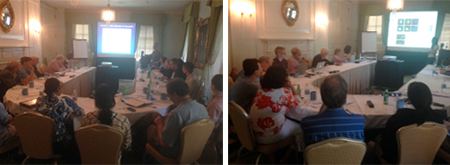by Monica Coenraads
There is no mystery about why a girl suffers from Rett Syndrome. The cause is the mutated copy of the MECP2 gene inhabiting her cells. But since MECP2 is on the X chromosome and all females have two X’s, beside each mutated gene rests a healthy but silenced twin. What if we could replace the flawed gene by reawakening its silenced counterpart? If we could wake up MECP2 in enough cells we could conceivably reverse Rett symptoms.

This is an approach that RSRT has championed since our launch in 2008. We are funding seven labs that are pursuing this line of work.
You may ask why do we need multiple labs working on the same goal. Isn’t that a waste of effort and money? The answer is a resounding “NO”. While the end game is the same each lab is using a different strategy to get there.
For example, the types of cells that labs are utilizing are different. Ben Philpot and colleagues at UNC are working with mouse neurons, Toni Bedalov and Jeannie Lee are using fibroblast cells, others still are using human cells. Each cell type has its own set of advantages and disadvantages.
The labs are also using different “reporters” – meaning how the cells are designed to detect activation of MECP2. Different compound libraries at different concentrations are being screened. Compounds are also being screened at various degrees of high and low throughput. And finally different criteria are being employed to define a “hit” (drugs that reactivate MECP2).

Bryan Roth gives us a tour of his robotic high-throughput
screening facility at UNC Chapel Hill
Having multiple labs attack this problem gives us more shots on goal and added assurances regarding the quality of any potential hits.
Two weeks ago we gathered everyone tackling this approach and brought them together for two intense days of talks and discussions.
Targeting MECP2 as a Treatment Strategy for Rett Syndrome
Chapel Hill, NC
May 12-13, 2014

Seventeen scientists from eight labs
plus advisors from NIH and industry participate at meeting in Chapel Hill, NC.
Over the past 15 years I’ve organized dozens of meetings and before each one I worry – will the discussions be forced or will they flow naturally? will collaborations ensue? It was no different with this meeting. The first few talks of the day however quickly put me at ease. While a number of common hits were reported in multiple labs much validating and further screening remains to be done. At the meeting, and in emails and phone calls since, the scientists are working out the logistics of validating each others hits, trading cell lines and compounds. Exactly the outcome I was hoping for.


8 comments
Comments feed for this article
May 27, 2014 at 3:53 pm
vicki girardin
Thank you so much for your hard work in keeping us all in the loop and simplifying it all. It was becoming so confusing as I tried to sift through bits of info. on line!!
As I am out and about many days I can see OHSU up in the hills of Portland and it reminds me again of all the hard work that is being done for my Samantha Thanks to all
May 28, 2014 at 1:18 am
Lisa Padilla
My daughter has Retts syndrome. I truly appreciate the dedication and hard work that every one has given to finding a cure for Retts. I wish there was more that I could do and contribute. Thank you again for your hard work and research.
May 29, 2014 at 10:26 am
billy & molly baine
brilliant news – keep up the good work –
May 30, 2014 at 7:47 pm
Amber n Chad
You truly have no idea how many parents and childrens lives you touch and give hope to just by what you do! A big thanks from a parent with a daughter with Rett Syndrome!! We need you!!!!!
June 3, 2014 at 9:18 am
Greg Hunckler
may God bless you daily as you research a cure for these girls. My granddaughter is so sweet but trapped inside and can’t do much. Please stay diligent in your work. Thank you sooooo much.
June 4, 2014 at 12:16 pm
Debbie & Rick
Monica,
I continue to be amazed at your dedication to finding a cure for our daughters. Every update provides me with the encouragement that a cure is on the horizon.
Thanks for all you do!!!
August 30, 2014 at 5:43 am
Sandra
Thank you for your work Monica. I follow the news on rett as my daughter struggles with this disorder.
September 10, 2014 at 10:48 pm
Hsien-Tse Tung
Not only in the US but also from all over the world are looking foward to your hard work and study. Thanks for all the members engaged in the research and blog. Your timely updated results give me hope to face the unknown future. Special appreciation to Monica, thank you!